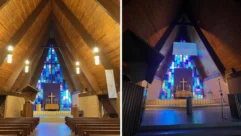Challenges on the Job
Nov 26, 2007 10:57 AM,
By Jessaca Gutierrez
Sidebar
Solving Challenges on the Job
Just about every installation has its challenges; some are unique, requiring more conversation with manufacturers or dealers; others are common with text book workarounds. James FitzGibbon, general manager of Rotech System Integration in Keyport, N.J., recently had his own challenges on commercial video installation for a pharmaceutical company. The installation included audio/video distribution into several areas: the main conference room, a second smaller conference room, the main lobby, as well as the owner’s main office, executive kitchen and pantry, and private onsite bedroom, which all cover more than 100,000 sq. ft.
The challenges: all of the audio and video sources for the seven high-definition televisions needed to be located in the server room that was more than 200ft. away, which meant that RGBHV plenum cable would be cost prohibitive; moving the existing server room to a new location more than 500ft. away; and installing CCTV cameras continually throughout the installation.
Working with Intelix, FitzGibbon was able to provide a cost-effective cable solution to span the distance between the server room and the audio and video sources. “In our installation using Cat-5e and baluns by Intelix made complete sense. In addition to the cost of material, pulling RGBHV cable is more labor intensive then pulling Cat-5e cable. The cable is thicker and heavier so it requires more labor to pull the cable. This is very true when you are pulling bundle of wires to multiply locations at the same time,” FitzGibbon says.
But the audio and video source distance wasn’t the only challenge. For the lighting control system, FitzGibbon used a Vantage Controls lighting system via an AMX control system that had to be connected via RS-232. The control panel was located about 200ft. away from the server room. “For integration of both systems, we used a piece of equipment made by Gefen (RS-232 Extender), which allowed us to send RS-232 commands from one system to another over a long distance,” he says.
The renovation of the existing structure contained several phases, which included moving the server equipment from the existing server room to the new server room, which was secured with access control. “The only thing that was left in the old server room was the Ethernet switch and patch panels for the network wiring for the office locations,” FitzGibbon says.
To cover the nearly 500ft. distance between the new server room and the old server, Rotech ran a six-strand 62.5 micron multimode fiber-optic cable to extend the network. “We choose to use media converters by Transition Networks (SGFEB1013-100) to convert the signal from copper to fiber and then back to copper,” he says.
Throughout the phases of installation, FitzGibbon was continuing to install CCTV cameras for the CCTV application, but not all the cameras would be installed at the same time. “So the two issues we faced was the distance and to have the ability to expand the system easily,” FitzGibbon says. “I choose to use two products by Network Video Technologies (NVT), which were a 4-channel passive video transceiver (NV-413A) and a 4-channel video active receiver (NV-452R).
“I picked five strategic locations within the building to mount power supplies and enclosures where the NVT transceivers would be located. This setup would allow us to keep the distance of coax and power wire to a minimum as well send four camera video signals over one Cat-5e cable back to the server room where the Dedicated Micros DVRs are located. At each of these five locations, we ran 2 Cat-5e cable, so it gives us the flexibility to add cameras throughout the whole building without doing additional work that is really not needed.”
In the end, Rotech was able to meet the needs of their clients, as well as provide a backbone of support to meet future needs. But the job wasn’t without challenges. “Every job has challenges some are harder then other to resolve,” FitzGibbon says. “To resolve problems it is just a matter of knowing the restriction of each product. When you come across a challenge you need to be able to come up with a solution.”
Solving Challenges on the Job
James FitzGibbon, general manager of Rotech System Integration, gives these pointers for trouble shooting challenges on the job:
The first step would determine what you can do to work around the issue. There are so many different products out there today and a lot of different pricing to go along with it. Maybe you know of a solution to a problem but have not had to use it yet. If so that is a great place to start, if not here are a few different things you can do:
- Speak to your dealers or distributors to see if they carry or know of a product that will make the installation be successful.
- Use a search engine to see if you can find any results that will guide you in the right direction.
- Speak to friends in the trade to see if they have come into the same problem and how they resolved it.
- If using a new product use a trusted brand name that is known for their quality products and technical support.
- Test the product in house during the design and engineering phase for proper operation. The last thing you need is to be surprised by a piece of equipment that does not work during the final stages of the job.










